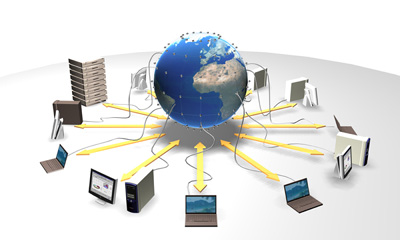Welcome to the DESY Grid pages. Some child pages are restricted to logged in users.
Contents
- Grid User Certificates
- Grid User Certificates New
- Grid VO Membership
- Grid Usage Examples
- Grid Pledges
- Grid Services at DESY
- Grid Talks and Contributions
- Installation
- Operations
- Virtual Organizations
- Links
- Security
- Statistics
- CVMFS repositories
- BOINC user computing
- CondorCE Setup
- Discussions
- Chitchat
- How-to articles
- Obsolete Documentation
- Security Delegation Exclusion Policy
Popular Pages
Since 2004 DESY operates a Grid infrastructure and has participated in national and international Grid projects such as EGEE (2004-2010), D-GRID (2005-2009), and EGI / NGI-DE (since 2010). In 2006 DESY became a Tier-2 centre (MoU signed 2006-02-08) for ATLAS, CMS, and LHCb as part of the Worldwide LHC Computing Grid (WLCG). In the context of the Physics at the Terascale project DESY operates the National Analysis Facility (NAF) which complements the Grid with interactive computing resources.
The DESY Grid infrastructure provides federated computing and storage resources for the WLCG virtual organizations (VO) 'atlas', 'cms', and 'lhcb', hosts the global VOs 'ghep', 'hermes', 'hone', 'icecube', 'ilc', 'ildg', 'xfel.eu', and 'zeus'., and supports 'belle'. From 2021 DESY is one of six Belle II Raw Data Centers.
In order to equip DESY and U Hamburg users with Grid user certificates, a registration authority (RA) serving the German certification authority (CA) at GridKa in Karlsruhe is available.
The global entry point for Users in the Grid is the Global Grid User Support (GGUS).
The Grid - explain it in 60 seconds
By Ian Foster, Argonne National Laboratory and the University of Chicago, published in the joint Fermilab/SLAC's magazine symmetry.
| Having bought a new toaster, we simply plug it in: the electric power grid removes the need to also buy and install a new generator. By analogy, information technologists refer to the Grid when talking about on-demand computing. Like its electrical namesake, a computing grid is a mix of technology, infrastructure, and standards. The technology is software that allows resource providers (whether individuals or institutions) to contribute computers, storage, data, networks, and other resources; it allows consumers to use them when needed. The infrastructure comprises the physical hardware and services that must be maintained and operated for the resource-sharing to occur. Finally, standards codify the messages that must be exchanged, and the policies that must be followed, to allow a grid to function. The Internet, Web, and Grid are related but distinct technologies. The Internet is the worldwide system of networks that connects many computers and smaller networks, allowing them all to communicate. The Web is a way of accessing information over the Internet. The Grid is a way of using the Internet to share and manage computing resources that are distributed around the globe. |
Acknowledgments and References
If you find the resource useful for your work, we would greatly appreciate to learn about publications, which have been substantially benefiting from the Grid Resources. Drop us a mail at grid@desy.de. Acknowledgement would also be greatly appreciated. It'll help to foster the cluster, for example: "This research was supported in part through the Grid computational resources operated at Deutsches Elektronen-Synchrotron (DESY), Hamburg, Germany"
A reference to a publication describing the Grid infrastructure at DESY is 'Interactive analysis notebooks on DESY batch resources' https://doi.org/10.1088/1742-6596/396/4/042026, J. Reppin et. al
BibTeX reference
@article{Haupt2012, doi = {10.1088/1742-6596/396/4/042026}, url = {https://doi.org/10.1088/1742-6596/396/4/042026}, year = {2012}, month = dec, publisher = {{IOP} Publishing}, volume = {396}, number = {4}, pages = {042026}, author = {A Haupt and A Gellrich and Y Kemp and K Leffhalm and D Ozerov and P Wegner}, title = {The {DESY} Grid Centre}, journal = {Journal of Physics: Conference Series} }
